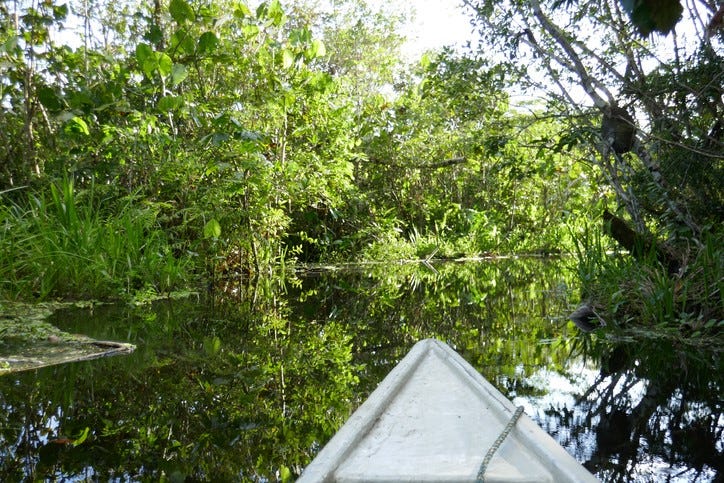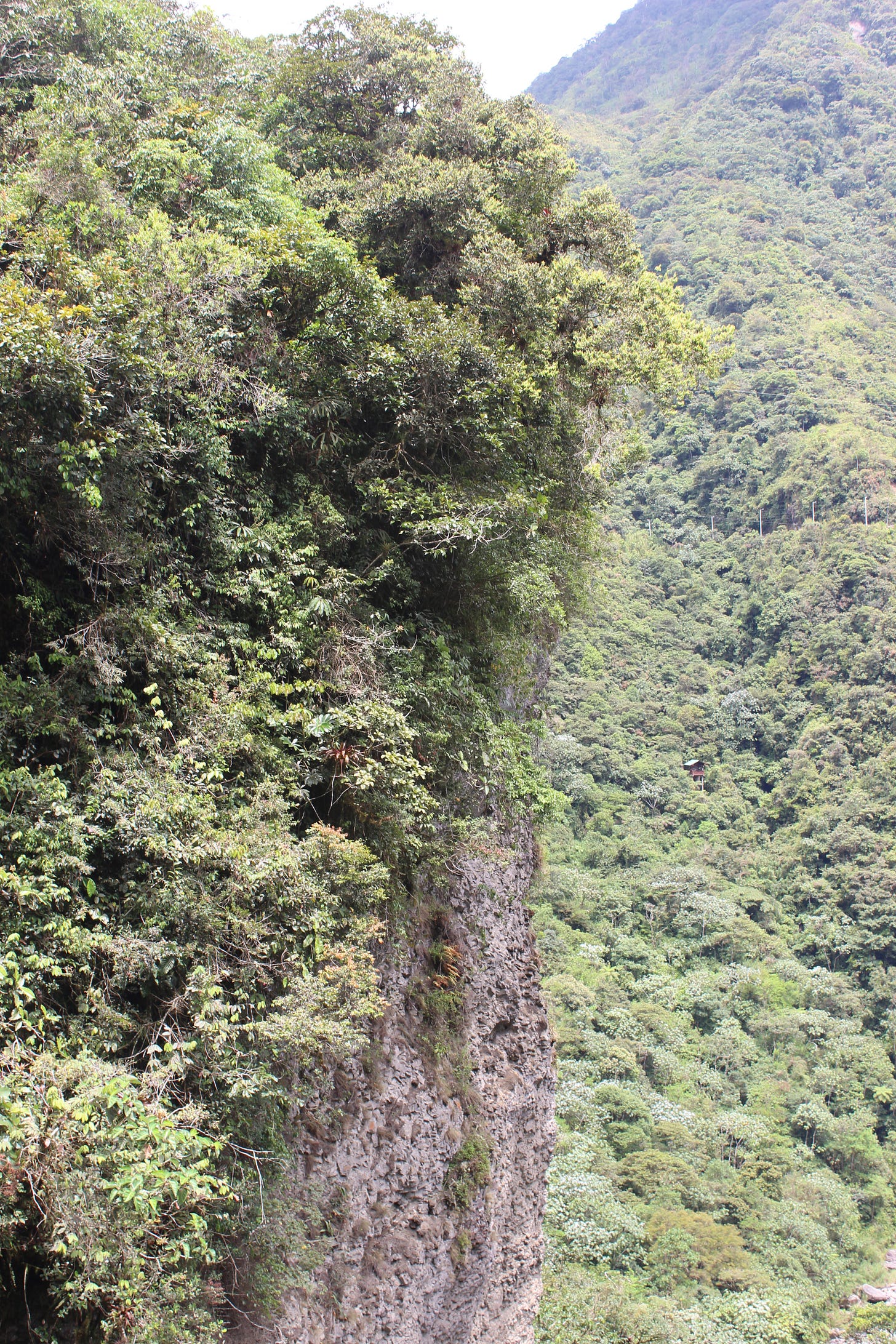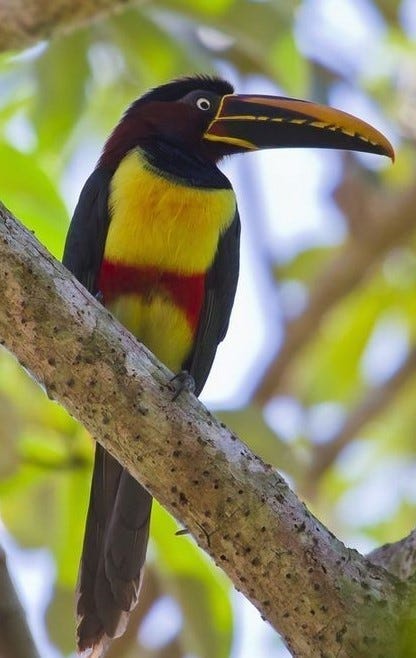Did I want to go hiking in the dense jungle off the banks of the Napo River in the Amazon Basin of Ecuador? Absolutely! Count me in!
Was I concerned about trekking out of my comfort zone into an untamed realm I knew practically nothing about? No problem.
I briefly recalled learning that Jaguars are the Top Cats of the Amazon Jungle. Animals and humans alike tremble in the presence of Jaguars. Although their six-foot long frames can tip the scale at 300 pounds, their TWELVE incisor teeth can rip through the toughest animal hides, and their retractable four-inch claws can slice with razor-sharp precision, Jaguars tend to get a bad rap. They DO NOT attack for kicks and giggles; they only attack when hungry.
Jaguars strike from behind. One STRONG CHOMP from the back at the base of the skull, and that’s it — Game Over!
It is futile to worry about being attacked by a Jaguar. If you fall prey to the Top Cat, you’ll never know what hit you because you’ll already be standing at the Pearly Gates.
Since I wasn’t concerned about the Top Cat, I wasn’t going to get all tied in a knot fretting about other dangerous critters like a 20-foot Anaconda Snake falling out of a tree and hugging me to death or an electric eel slithering in my direction to zap me with enough electricity to stun the toenails off an elephant. However, our guide, aptly named JungleJim, didn’t share my nonchalant approach to this escapade. He whipped out an official-looking folder of legal waivers for us to sign that released him from liability if we did goofy things like swim with the Piranhas or play with the Poisonous Dart Frogs. Hubs and I humored JungleJim and signed the documents.
Note to self: Don’t touch the pretty fish and frogs - they’re deadly.


With the paperwork taken care of, we swapped our shoes out for some “standard-issue going-in-the-jungle gumboots” and hopped in the motorized canoe. A couple of miles upstream on the Napo River, JungleJim maneuvered the canoe toward the right bank and slipped it into a small opening in the rainforest. All was still and quiet except for the steady putt-putt sound of the small motor on the back of the canoe.
Positioning the bow so it pointed toward the shoreline, JungleJim cut the motor, and the canoe drifted to a grinding stop against a small sandbar. The trailhead, which started just beyond the sandbar, disappeared rapidly into the dense foliage. Within minutes, the canoe was secured, and we were on our way, beginning the ascent up the rustic trail.
As we picked our way over the tangled tree roots and plant runners crossing the trail, JungleJim talked about the surrounding flora. My survival instinct was triggered in direct proportion to the amount of information he shared. My vision ramped up to LASER-FOCUS, and every plant was suspected of being a lethal weapon. We were in the midst of a minefield of toxic plants!
Take, for example, the unassuming Castor Bean Plant, aka Ricinus Comunis. Castor oil is an amazing natural substance with phenomenal benefits; it’s a wonder we don’t race to the grocery store to buy it by the gallon! Whether the task is to induce labor, grow longer eyelashes, repel moles in your yard, treat acne, fight toenail fungus, treat scalp conditions, deep cleanse skin, thicken eyebrows, relieve arthritis, improve immune function, or relieve constipation - castor oil can get the job done and a whole lot more! (Click here for information.)
Castor beans contain Ricin, an acutely toxic protein. Ricin is reputed to be 6,000 times more poisonous than cyanide and 12,000 times more poisonous than rattlesnake venom! The stuff is playing for keeps!
JungleJim got his message across loud and clear: Be on Guard for Poisonous Plants!
The trail steadily headed in an uphill direction. With all the vegetation, it wasn’t possible to see where we were heading. Occasionally, the curtain of foliage would open, and we caught a glimpse of our surrounding environment.
A mighty Andean Condor displayed his massive 10-foot wingspan for us as he soared in the skies around the jungle cliff in the above photo. Although the Condor is the largest flying bird on earth, it flew with awe-inspiring grace and elegance. A truly spectacular site!
There was more to the jungle cliff than the Condor siting. The cliff flanked one side of a deep gorge, and it had a counterpart flanking the opposite side. A rustic suspension bridge that spanned the length of the chasm served to connect the sides.
I started to feel like Jane of the Jungle’s twin sister. There was no turning back, but moving forward looked rather ominous. Well, I signed myself up for this jungle jaunt, so away I went…


The bridge bounced treacherously with every step I took. It wobbled to and fro, then reverberated in waves, rocking back and forth. The boards creaked and groaned beneath my feet, prompting me to question the stability of the aging wooden planks. I tried to quicken my pace and end this perilous walk, but the sway of the bridge pushed the limits, forcing me to bring the tempo back down to a snail’s pace. One step at a time, I finally got to the other side of the deep gulley.
On the bright side, at least I had a bridge to walk across - I didn’t have to grab a jungle vine and swing Tarzan-style across the precipice.
JungleJim was quick, “Careful! Danger! There’s an Assassin Bug on that leaf.” He pointed to a brown, winged bug that was just over half an inch long. JungleJim didn’t need to warn us twice - anything named “Assassin Bug” probably wasn’t something we wanted to tangle with.
Assassin Bugs are nasty, predatory insects that inflict painful bites and inject poisonous toxins into their prey. While there are 7,000 species of this ornery bug, the most cantankerous of all, the Triatominae (Kissing Bug), lives in Central and South America. These barbaric beasts inflict painful wounds or allergic reactions. In severe situations, they carry Chagas Disease, a condition that causes several life-threatening complications. Assassin Bugs look like ordinary, average bugs, but looks can be deceiving.
With all the poison and different types of toxins, it’s a real jungle out there!
This is an Amazon Leaf Bug. When it opens its wings, it looks EXACTLY like the leaf in this photo. Surprise! The Leaf Bug is NOT toxic and it’s a sociable little creature.
The trail turned abruptly to the right and started a steep descent back down to the Napo River. As we navigated our way carefully down the muddy path, our presence spooked a small flock of Chestnut-Eared Aracari Toucans perched in the upper branches of the trees. The birds took off flying with a frenzied scurry of flapping wings and frantic squawking. Whoosh! They were like a sudden gust of wind blowing overhead - then they were gone!
The canoe was grounded on the sandbar and tethered to a tree, exactly as we left it earlier in the day. We all pitched in to help drag it across the sandbar and set it afloat in the quiet lagoon of the Napo River. We jumped in the canoe, and Hubs pushed it away from shore with a paddle. JungleJim started the engine. Backtracking the same route from the morning, we headed toward the main tributary of the Napo.
In the quiet of the late afternoon, a shadow emerged from the jungle. It moved, sight unseen, across the sandbar and inconspicuously slipped into the water. The Jaguar swam to the end of the lagoon and watched until the three humans in the canoe turned east into the Napo River. Satisfied they were gone, the Top Cat of the Amazon turned around and returned to the jungle. All was well in the Jaguar’s domain.















What an amazing day you had! I’m sure it was terrifying and exciting all at once.
You know things are serious when the guide offers legal waivers to sign. That sounds like an amazing experience, Lois. Especially the opportunity to see a jaguar!